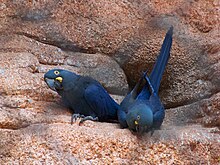| Lear's macaw | |
|---|---|

| |
| Scientific classification | |
| Domain: | Eukaryota |
| Kingdom: | Animalia |
| Phylum: | Chordata |
| Class: | Aves |
| Order: | Psittaciformes |
| Family: | Psittacidae |
| Genus: | Anodorhynchus |
| Species: | A. leari
|
| Binomial name | |
| Anodorhynchus leari Bonaparte, 1856
| |

| |
Lear's macaw (Anodorhynchus leari), also known as the indigo macaw, is a large all-blue Brazilian parrot, a member of a large group of neotropical parrots known as macaws. It was first described by Charles Lucien Bonaparte in 1856. Lear's macaw is 70–75 cm (27+1⁄2–29+1⁄2 in) long and weighs around 950 g (2 lb 2 oz). It is coloured almost completely blue, with a yellow patch of skin at the base of the heavy, black bill.
Although there are records of the macaw from Britain from the early 1830s, this bird was only generally recognised as an independent species in the late 1970s. It is rare with a highly restricted native range, which was only discovered in 1978, although intensive conservation efforts have increased the world population about thirtyfold in the first two decades of the 21st century. It inhabits a dry desert-like shrubby environment known as caatinga, and roosts and nests in cavities in sandstone cliffs. It mostly feeds on the nuts of the palm species Syagrus coronata, as well as raiding maize from local farmers. Its ecology also appears curiously linked to cattle ranching.
- ^ BirdLife International (2020). "Anodorhynchus leari". IUCN Red List of Threatened Species. 2020. Retrieved 9 October 2021.
- ^ "Appendices | CITES". cites.org. Retrieved 2022-01-14.
